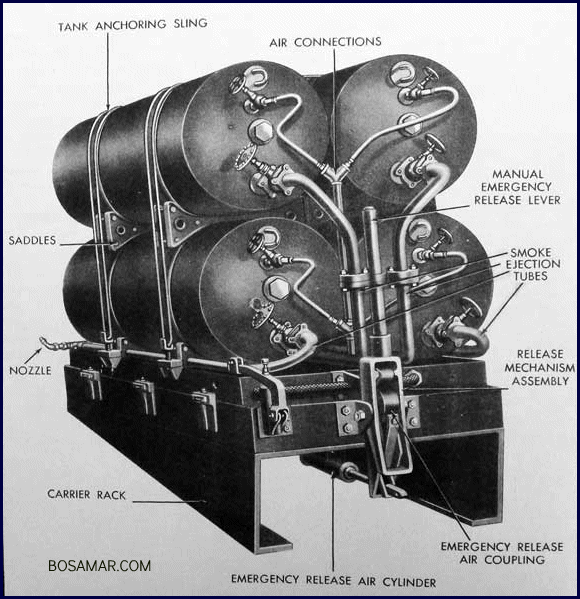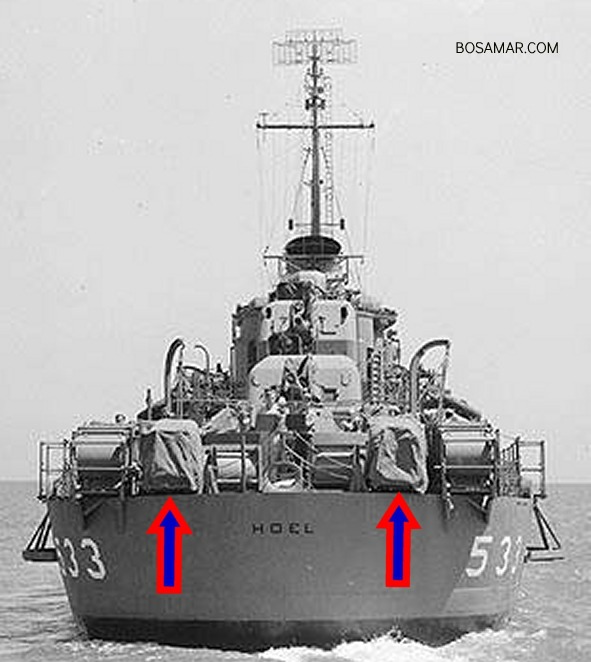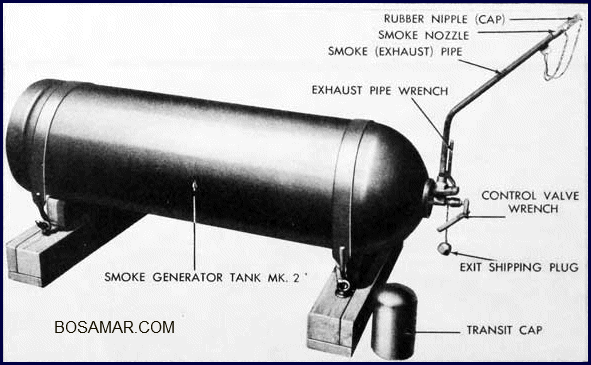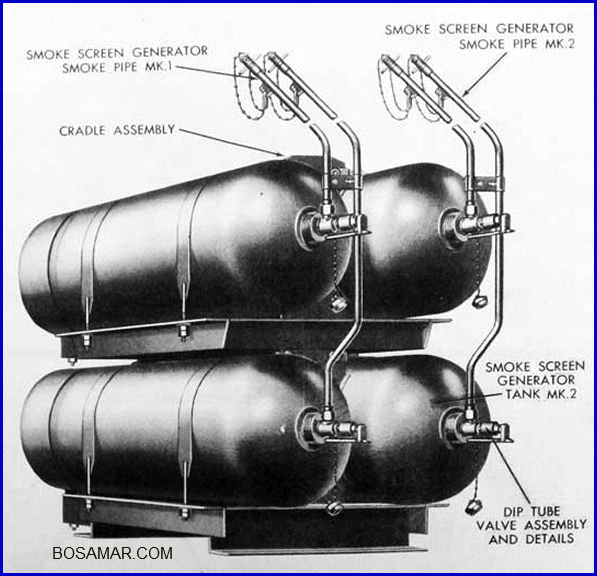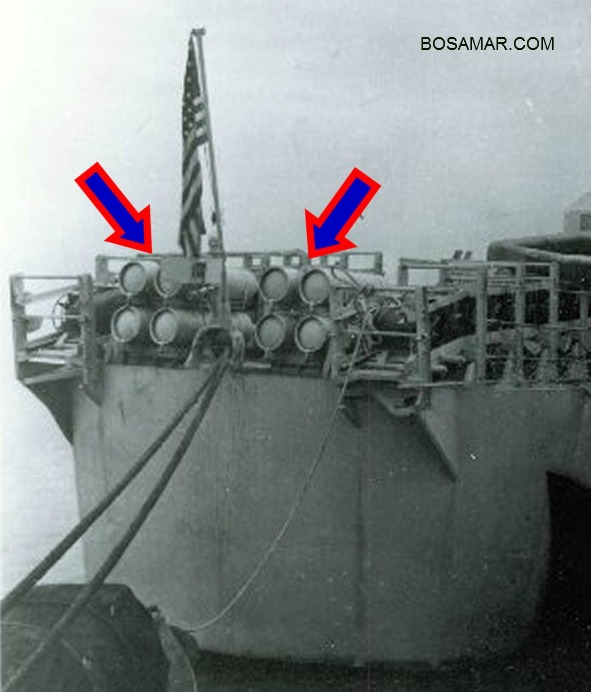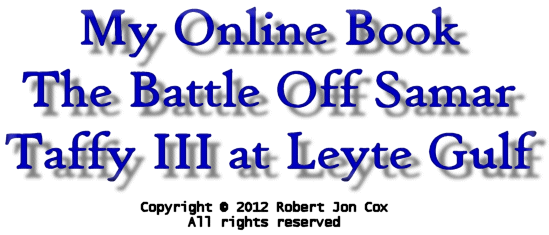
COMMENTS ARE ENABLED ON THE BOTTOM OF THE PAGE
Chapter 14
EPILOGUE
The reason for VADM Kurita's withdrawal was never clearly explained by the admiral, even after intense interrogation by U.S. officials after the war had ended. When Centre Force broke off action with Taffy III and headed north to regroup, it was still considered a very potent force to be reckoned with. At this time Centre Force consisted of battleships YAMATO, KONGŌ, HARUNA, and NAGATO, heavy cruisers TONE and HAGURO, light cruisers NOSHIRO and YAHAGI, and at least six to eight destroyers. Vice Admiral Kurita's force was far from defeated and was more than capable of proceeding toward Leyte Gulf to complete its "one- way" mission. Unknown by VADM Kurita at the time, there was little along the way to stop him if he chose to do so.
|
If the remaining ships of Centre Force had continued their sortie toward Leyte Gulf, it would have been interesting to see how RADM Oldendorf's old battleships and Seventh Fleet surface forces would have dealt with them. As stated earlier, the Seventh Fleet supply of armor-piercing ammunition was nearly depleted after their action in Surigao Strait. Since the old battleships were at least five knots slower than those of Centre Force, a running fight was not desirable. At the direction of VADM Kinkaid, RADM Oldendorf deployed three old battleships, five cruisers, and two destroyer squadrons twenty-five miles eastward of the northern entrance to Surigao Strait. The remaining forces belonging to the Seventh Fleet were kept well inside of Leyte Gulf. Whether these two groups could have effectively engaged and defeated the IJN Centre Force would never be known. |
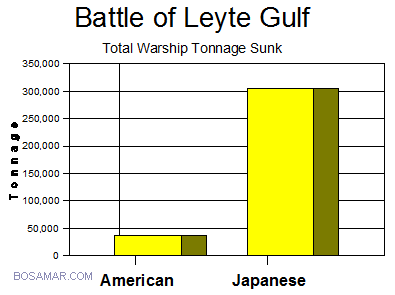 |
The Americans lost six warships at Leyte Gulf, almost 37,000 tons. Compared with the Japanese loss of 26 warships weighing over 306,000 tons, it was clearly an American victory. The Japanese loss figures are remarkable considering how ADM Halsey’s Third Fleet failed to adequately deal with Centre Force’s egress and return to San Bernardino Strait. The numbers most likely would had been much higher and perhaps one-sided, if ADM Halsey's Task Force 34 would have met Centre Force as it debauched from San Bernardino Strait at midnight on October 24th. The total tonnage of the twenty-three IJN Centre Force warships which transited through San Bernardino Strait at this time was about 318,000 tons. The match-up between Vice Admiral Kurita’s Centre Force and VADM Lee’s 16-inch gun fast-battleships of TF 34 in San Bernardino Strait would had made the action in Surigao Strait look modest.
| Five of the ten American ships sunk in the Battle of Leyte Gulf were from Task Unit 77.4.3 (Taffy III), four of which, were sunk directly by VADM Kurita's Centre Force gunfire. The costs in lives to Taffy III were 898 dead and 913 wounded. A large majority of these deaths occurred during the two days the crews of CVE GAMBIER BAY, DD JOHNSTON, DD HOEL, and DE ROBERTS tragically spent in the water awaiting rescue, another grave error committed by the American command. The two remaining American vessels, both carriers, CVE ST LO and CL PRINCETON, were sunk by separate kamikaze attacks.
The figures below do not include those ships damaged on both sides. 1 Light Carrier: PRINCETON 2 Escort Carriers: GAMBIER BAY & ST LO 2 Destroyers: HOEL & JOHNSTON |
USS SAMUEL B. ROBERTS (DE 413) The success which was obtained by this Task Unit, being unsupported by heavy ships, submarines, or adequate aircraft, in what might be called a surprise engagement with an overwhelming enemy task force seems like a myth. Why this ship was not sunk long before it was will ever be a mystery - except for one concrete fact which is here advanced, - namely that the silhouette of the WGT type destroyer escort furnishes no real point of aim, and is, defensively, one of the best silhouettes of all the navies of the world. This may also account for the fact that no hits were received in the bridge superstructure. The fact that we could stay afloat for over an hour within 7500 yards gun range of Japanese cruisers also seems to testify to the very pitiful efforts of Japanese gunnery, in so far as this action is concerned, as well as the kindness of providence. |
1 Destroyer Escort: SAMUEL B. ROBERTS
1 Submarine: DARTER
1 Landing Craft (Infantry): LCI-1065
1 Motor Torpedo Boat: PT 493
1 Fleet Tug: SONOMA
The Japanese lost twenty-six front line warships during the Battle of Leyte Gulf.
1 Fleet Carrier: ZUIKAKU
3 Light Carriers: ZUIHŌ, CHIYODA, & CHITOSE
1 18-inch Battleship: MUSASHI
2 14-inch Battleships: YAMASHIRO & FUSŌ
6 Heavy Cruisers: ATAGO, MAYA, SUZUYA, CHŌKAI, CHIKUMA, & MOGAMI
4 Light Cruisers: NOSHIRO, ABUKUMA, TAMA, & KINU
9 Destroyers: NOWAKI, HAYASHIMO, YAMAGUMO, ASAGUMO, MICHISHIO, AKITSUKI, HATSUTSUKI, WAKABA, & URANAMI
Vice Admiral Kurita's reasons for withdrawal no doubt must have been many. We can only speculate about what his concerns were which led to this decision. Here is what I believe he was faced with:
|
CTU 77.4.3/COMCARDIV 25 Action Report The success attendant upon the efforts to escape the devastating enemy fire was remarkable almost to the point of being unexplainable. After being under enemy fire for two and one half hours at ranges closing to under 10,500 yards, this Task Unit lost one carrier, and two DDs and one DE. These escorts were lost as a result of their heroic torpedo attack into the center of the enemy under very heavy fire. U.S.S. ST. LO (Ex MIDWAY) was lost sometime later, after the enemy had begun retirement, as a result of a successful suicide dive into the middle of her flight deck and subsequent explosions. From almost the beginning of the action, heavy funnel and FS smoke was laid by all vessels. This, together with a providential rain squall, seemed to bother the enemy fire control parties to an unusual degree, resulting at times in lulls in the firing, and perhaps indicating lack of use of radar fire control for surface gunnery. As to why the main Jap plan failed, there are the following concrete reasons: (a) The losses and damage sustained by the southern group and the failure of any of them to force the Surigao Straits. (b) The losses and damage sustained by Jap forces en route to the Philippine area from our submarines. (c) The losses and damage sustained from CVE air attack. (d) The poor training of the suicide squadron in locating and crippling the CVEs and thus preventing further damage from our air attack. (e) And very fundamentally, the decision of the Jap commander to retreat at the time he did. |
- The Japanese Southern Force Van’s unsuccessful sortie and their nearly total destruction and the Southern Force Rear's hasty retreat. As originally planned, VADM Kurita had expected to meet with these forces in Leyte Gulf and, just prior to meeting Taffy III, learned of their fate which obviously must have had been a great let down. The failure of VADM Nishimura and VADM Shima to coordinate their attack was disgraceful and leads one to speculate once again, what would have happened...
- Vice Admiral Kurita was told the enemy had requested aid from friendly forces by plain-language telephone (TBS) and in reply, it was stated help would arrive "...in about two hours....". More complications in the heat of battle caused by poor intelligence information.
|
CTU 77.4.3/COMCARDIV 25 Action Report It is not too difficult to surmise with some accuracy the contributory reasons why the Jap OTC made the very poor decision of breaking off the action with the CVEs and withdrawing the same way he came. From our viewpoint, this decision seems to be the only sure factor which made the difference between success and failure for the Japs. Had this decision not been made, the Jap main body could have, and should have, waded through and completed the destruction of this Task Unit, and continuing to the south, would have found our naval opposition very low on ammunition following their night action. In Leyte Gulf, they could have successfully accomplished their mission and retired through Surigao Straits as was originally intended. During this time, they would have been exposed to only minor damage from weakened CVE air attacks (whose largest bomb was 500-pound SAP) plus belated air strikes from Task Group 38.1 which were going to occur anyway. |
perhaps another powerful section of Third Fleet. He simply did not know how many carriers the Americans had. More complications caused by poor intelligence information.
- The sighting of a "PENNSYLVANIA" Class battleship mast. Although only an apparition, more complications caused by poor intelligence information and an exhausted mind.
- An unconfirmed report was received of another American carrier Task Group northeast of Samar. More complications caused by poor intelligence information.
- The vessels of Centre Force were low in fuel and needed to conserve their remaining supply. Although this was to be a one-way sortie to Leyte Gulf, "...without regard for any damage we may suffer...." it seems VADM Kurita was less than willing to let his entire force be destroyed while attempting to complete his mission.
- Centre Force needed time to transit back through San Bernardino Strait near sunset or during the night when the chance of an air attack was thought to be least likely. In addition, VADM Kurita felt he needed to put as much distance as he could between Centre Force and the Philippine Sea by morning so he would not repeat the same fate as he suffered the day before in the Sibuyan Sea (massed Third Fleet air attacks).
Next we will examine what the Japanese did right at Leyte Gulf:
Despite all their errors, the Japanese came very close to accomplishing their mission at Leyte Gulf. Their original plan, with all of its crucial inadequacies and poor planning, nearly worked. Although the Battle of Leyte Gulf resulted in an overwhelming American victory, much did go wrong on the side of the U.S. Navy. Here, in my eyes, is how the American’s blundered:
|
CTU 77.4.3/COMCARDIV 25 Action Report FACTORS WHICH ARE BELIEVED TO HAVE INFLUENCED THE OTC OF THE JAP FLEET:
|
- Admiral Halsey’s failure to form Task Force 34 on the night of 24 October and his subsequent unwillingness to leave it to guard San Bernardino Strait before heading north to engage the bait Northern Force.
- Once ADM Halsey decided to head northward to engage the Northern Force, he failed to initially split his forces to guard against all contingencies. After much rousing, he ultimately did divide his forces when it was too late and without results. This snafu became known as the "Battle of Bull’s Run."
- Vice Admiral Kinkaid should have been more aggressive in his reconnaissance of San Bernardino Strait, regardless of whether he thought Third Fleet was covering his northern approaches.
| SHIP'S CHEMICAL SMOKE MUNITIONS - Description and Instructions for use Department of the Navy Bureau of Ordnance ORDNANCE PHAMPHLET NO. 1042 - 25 September 1943 |
|
The smoke screen created by the escorts of Taffy III played a major role in the escape of the escort carriers. Therefore I feel this section merits mention in detail. All ship specific information is taken directly from their Action Reports. USE BY ESCORTS OF TAFFY III There were two primary types of chemical smoke available for use by the destroyers and destroyer escorts, FS or FM. FS generated a dense, white, corrosive smoke. It was a solution of sulfur trioxide in the liquid chlorosulfonic acid. It was a heavy, fuming liquid, and weighed about 16 pounds per gallon. In contact with air it reacted with the moisture present to form a mixture of sulfuric and hydrochloric acid mist. FM reacted with the moisture in the air to form a dense, white, persistent smoke cloud. It was a compound of titanium tetrachloride. It was used with carbon dioxide (CO2) as the pressure producing agent, and sometimes with the addition of a small percentage of other chemicals. The smoke mixture was a corrosive colorless to yellow liquid that weighed 14 pounds to the gallon. It reacted vigorously with the moisture in the air to form a combination smoke (finely divided titanium hydrate particles) and mist (hydrochloric acid vapor). Due to the hydrochloric acid, the liquid was highly corrosive, but the smoke, while acrid, was not sufficiently irritating in field concentrations to cause coughing or other physiological effects to the respiratory system. Careful review of their Action Reports revealed that both types were used: FLETCHER Class Destroyers
No destroyer Action Reports detailed the exact smoke screen generator type. The author makes the assumption from Ordnance Phamphlet No. 1042, Action Reports and photographs that all three FLETCHER Class destroyers used the Mark 1 FS Smoke Screen Generator. Only JOHNSTON and HEERMANN's Action Reports mention FS by name. Photographic evidence of HOEL's stern leads to the same conclusion. BUTLER Class Destroyer Escorts
The author makes the assumption from Ordnance Phamphlet No. 1042, Action Reports and photographs that all BUTLER Class destroyer escorts used either the Mark 4 or Mark 6 FM Smoke Screen Generator. Only DENNIS and RAYMOND's Action Reports mention FM by name. Photographic evidence of DENNIS' stern in December 1944 clearly shows two Mark 4 FM Smoke Screen Generators. However, ROBERTS mention of FS four times in her Action Report leaves a question mark. USE BY CVE's OF TAFFY III Careful review of escort carrier Action Reports revealed the following concering the use of smoke
FS SMOKE SCREEN GENERATORS There were three Navy generators designed for generation of FS smoke screens from surface vessels, the Mark 1, Mark 2, and Mark 5. The Mark 1 generator was designed for use on destroyers (including the FLETCHER Class) and larger vessels. The Mark 2 and Mark 5 generators are designed for use on smaller vessels. MARK 1 FS SMOKE SCREEN GENERATOR. The Mark 1 Smoke Screen Generator and Modifications was composed of four 35-gallon Mark 1 smoke screen tanks, which were mounted as a single unit. Each tank had its own pressure line, exhaust tube, and nozzles. The complete unit of four tanks could be immediately jettisoned, either locally by pulling the manual emergency release lever, or remotely by a quick operating air valve. The tanks were designed for operation at pressures ranging up to 150 pounds per square inch. The generator tanks were fabricated from welded sheet monel (nickel and copper, with some iron) metal. Within each tank were baffle plates to add strength and minimize surging, and a discharge tube, the purpose of which was to empty the tank as completely as possible by taking the liquid from the low end. On the outside of each tank were two reinforcing bands, which located and restrained the tank in its mounting; a filling fitting; a flange for smoke exhaust line connection; and a pipe threaded air inlet tube.
U.S. Navy Technical Drawing Mark 1 FS Smoke Screen Generator The Mark 1 smoke screen tanks were mounted in saddles, the lower set of two being welded to the emergency release carrier, while the upper two rested on the lower two tanks. The tank reinforcing bands served to properly position the upper two saddles. The tanks and upper saddles were secured to the release carrier by tank anchoring slings. The clevis bolts of these slings extended through the cable anchor brackets, the slings being secured and tightened in place by common nuts which, in turn, were secured by check nuts. Spherical washers were provided so that the clevis bolt nuts would not bear directly against the cable and anchor brackets. The emergency release carrier was, in effect, a skid upon which were mounted the generator tanks. It also mounted all piping necessary to conduct air from a single connection (which was fixed to the ship's structure) to each tank, and to the piping and nozzles by which the smoke mixture was discharged from the individual tanks. The carrier was restrained vertically by four keys, one adjacent to each corner, which engaged suitable parts of the carrier rack. The carrier was normally held in place on the carrier rack by means of a latch bracket secured to the inboard end of the emergency release carrier. This bracket was fitted with a toggle pin which restrained the latch, and this toggle pin had to be removed from the bracket before the carrier could be jettisoned.
U.S. Navy Photograph USS HOEL's Mark 1 FS Smoke Screen Generators, covered and Generator air piping, which started at the permanent supply line and terminated in the air coupling body at the inboard end of the carrier rack, consisted of an air coupling cap, a section of flexible hose, and a piping manifold arranged so that the flexible hose could be connected at either side, and contained two double branch laterals providing four connections from which connecting pipes ran to each individual tank. A three-eighths inch stop valve, to select the particular tank or tanks for discharge, and a spring loaded ball check valve, to check the air line against the smoke mixture, were provided in each line from manifold to tank. Generator smoke lines, which were individual lines, each contained a 1.0 inch stop valve, ran from each tank to one of four spray nozzles, these spray nozzles being mounted at the outboard end of the emergency release carrier. The spray nozzles were intended to emit the smoke mixture in finely divided form, the resulting spray to form a comparatively wide cone. Nozzles were made adjustable in order to obtain the optimum spray, but the adjustment, once determined, was not intended to be altered in service except to re-establish the original setting. Filling were provided for each tank. They were intended for use only when tanks were to be filled with smoke mixture, or when, having been discharged, tanks were to be flushed with water. Under normal operating conditions, a filling cap was never opened unless the tank was known to have been completely discharged, and then only with precautions.
FM SMOKE SCREEN GENERATORS There were two smoke screen generators designed to use FM for the generation of smoke screens from surface vessels, the Mark 6 and Mark 4. MARK 6 FM SMOKE SCREEN GENERATOR. The Mark 6 Smoke Screen Generator consisted of a smoke screen tank Mark 2, fitted with a manual control valve and an exhaust tube designed to operate with or without one of four different sized nozzles. Integral with the valve was a syphon tube extending into the tank and converting the tank into a steel syphon bottle.
U.S. Navy Technical Drawing Mark 6 FM Smoke Screen Generator The smoke tank Mark 2 was a commercial ICC-3A480 full spun steel ammonia cylinder with a capacity of about 33 gallons. It was designed for a working pressure of 480 pounds per square inch, and is tested at 800 pounds per square inch. The valve was brass, with a copper syphon tube sweated into it with soft solder. The exhaust tube was stainless steel, and the four nozzles were brass. Chained to the exhaust tube was a rubber cap, which fit onto the end of the tube, or onto any of the nozzles to prevent water from entering the tube when the generator was not in use. Smoke screen control was obtained by the choice of the nozzle used. The rate of discharge varied with the size of the nozzle. The discharge time also varied with the pressure, and therefore with the temperature. As an example, the discharge time with the No. 42, the smallest, nozzle was about 25 minutes at 45°F and only 12 3/4 minutes at approximately 75°F. MARK 4 FM SMOKE SCREEN GENERATOR. The Mark 4 Smoke Screen Generator was essentially four Mark 6 generators mounted on a single frame. Each held 22 gallons of FM with CO2 as the dispersing pressure agent. It was used on such vessels as destroyers. All instructions and precautions given for the Mark 6 generator were equally applicable to each unit of the Mark 4 smoke screen generator.
U.S. Navy Technical Drawing Mark 4 FM Smoke Screen Generator The filling of the Mark 4 and Mark 6 smoke screen generators was the same, except that with the Mark 4 generator there were four tanks to fill. Each tank was filled in two steps: First, 310 pounds (22 gallons) of FM or modified FM were poured into the tank, then 16 pounds of CO2 was added. Either Navy Filling Equipment Mark 1 Modification 4 or improvised equipment was used for the FM filling. If the Navy equipment was used, the strainer was first removed.
U.S. Navy Photograph USS DENNIS's Mark 4 FM Smoke Screen Generators. The CO2 filling line was similar to the one used to refill fire extinguishers except that one end was modified to fit the generator valve at the exhaust tube connection. This line included a flow pump if possible, otherwise gravity flow was used with the CO2 cylinder raised a few feet above the generator tank. The FM or modified FM was available in 55-gallon steel drums. Each drum had two openings with standard pipe threads, a three-fourths inch opening at one end and a two inch opening in the side. The CO2 was provided in 50 pound lots in cylinders. Only liquid CO2 was used. |
The escort carriers at Leyte Gulf were not suited for what occurred off Samar. Rear Admiral Ralph A. Ofstie, CTU 77.4.32/ COMCARDIV 26 being in secondary command of Taffy III aboard CVE KITKUN BAY was in the status of observer during these actions. His Comments and Conclusions report of November 14, 1944 boldly assessed his perceived shortcomings of the escort carriers:
| Commander Task Unit 77.4.32/COMCARDIV 26 Comments and Conclusions RADM Ralph A. Ofstie, USN |
|
DEPLOYMENT OF COMBAT ESCORT CARRIERS In each successive amphibious operation the escort carriers have undertaken an increasing share of the direct air support. This mission has been accomplished heretofore in a uniformly excellent manner. The experience of the Leyte campaign, however, has shown that the demands of current and probable future operations are beyond the reasonable capabilities of these vessels, and that their future employment in furnishing air support will probably be precluded. Our Pacific offensive has suddenly projected us into the inner defenses of Japan. We are on the point of severing the supply and communication lines between the homeland and that occupied empire to the south which furnishes raw materials and fuel. At the same time we have captured and are expanding positions from which air forces should blast and burn down the major industrial-population centers of Japan which manufacture and construct the weapons of war. The enemy fully appreciates the disaster which faces him: hence the fieroeness of his ground resistance at SIAPAN and PELLELIU, the commitment of his entire fleet in opposing the Leyte occupation, and the recent fanatical suicide attacks of his airmen. If our reports and claims have not been grossly over-exaggerated, the enemy has now lost or had severely damaged the bulk of his surface naval forces. Teh latter therefore constitute a greatly reduced threat which permits a corresponding reduction of our own naval forces held ready to counter his possible actions. But the scale of his resistance will certainly continue at the maximum of which he is still capable, employing all arms and branches to their absolute limit. In these circumstances it would appear that the time has come to employ units of the fast carrier task forces for the primary direct air support of major amphibious operations in the Western Pacific, and to relegate the CVE's to tasks more in line with their original concept and proven capabilities. The CVE's have done and can still do a fine job within their limitations. When more is required, the task must be turned over to ships more adequate to the demands. LIMITATIONS OF CVE'S There has been an increasing tendency to present the combat escort carriers, when operated in suitable numbers, as comparing rather favorably with the fast carriers in practically all essentials except speed. This can perhaps be charged to over-enthusiasm resulting from the highly creditable and thorough manner in which CVE's have heretofore furnished support for amphibious operations. When the going got tough, however, and these ships were subjected to serious enemy surface and air action as was the case at LEYTE, the deficiencies and limitations of the class became extremely pointed. The major features contributing to this unfavorable status are: (a) A maximum sustained speed of about 18.5 knots, with the resulting restriction on choice of position, defensive maneuvering, and ability to operate aircraft under low wind conditions. The last may require substantial reduction of aircraft loading. (b) Consequent to (a), plus a short flight deck, the plane complement necessarily comprises types of reduced performance. (c) Anti-aircraft gun defense is weak, the result both of the numerically limited battery in the carriers and the small screening strength normally furnished. (d) A mediocre radar installation, with SG and SK only, lacking the comprehensive and efficient coverage given by the SM. (e) The CVE's are not "hard". For all practical purposes they are simply converted merchant hulls. They have little of the compartmentation and generally heavy structure of normal combat vessels designed to obsorb punishment. (f) Little unity in organization, training and operational experience. The escort carriers are subject to not infrequent shifts in type of duty performed and in the units with which they work. The screening vessels assigned are generally "pick-ups" gathered at random for each operation. The senior command organization is seldom the same. These are factors which are hardly conducive to the formation of an effective fighting force. All of these items are not necessarily critical at any one time, but under average service conditions the type is always handicapped to an important degree. |
Admiral Clifton Sprague in his October 29, 1944 Action Report penned this about the Japanese strategy:
"Since the time the U.S. Navy recovered from the Pearl Harbor attack and outgrew the Japanese Navy in size and effectiveness, the enemy naval strategy could only follow one general plan: to successively concentrate overwhelming forces against well separated parts of our fleet which became exposed.
The tactics which resulted in the events of 25 October 1944 followed just such a plan. The plan was daring, and boldly carried out. Japanese naval forces departed from Singapore, Borneo, Celebes, and Formosa bases at such times as would permit them to arrive in the Philippines area on the evening of 24 October 1944. One group of ships, probably composed of 2BB, 4 or more CA and numerous destroyers, was to sortie through Surigao Strait and enter Leyte Gulf from the south. A second force probably composed of 6 BB, 8 CA, and 13 or more DD was to trasnsit San Bernardino Straits and proceed to the south and enter Leyte Gulf from the north-east. These two groups were to operate together to destroy all U.S. Shipping in Leyte Gulf. To allow this plan to succeed the Japanese had to remove the certainty of too heavy an air attack while making their final approach. They know definitely the size and composition and operating areas of the three groups of CVE's which were operating to the eastward of Leyte and Samar because each group had been scouted by enemy planes at least once during the previous five days. These ships were to be nullified by shore based air attack, including suicide crash dives on the carrier decks. The existence of a special group of suicide pilots had been indicated in previous intelligence information and it is thought this group was organized with the specific objective of wiping out the local carrier based air strength with cold-blooded certainty. As for the fast carrier groups, there are two possible lines of Japanese thought, one, that they believed a large part of their own claims of damage to the U.S. Fleet following the strikes on Formosa and that their force sent down from the north was intented to be large enough to contain the remnant U.S. forces. But it is considered far more probable that the Jap high command had a very realistic conception of the remaining strength (and approximate position) of the THIRD FLEET and that the Jap northern force was not meant to be of sufficient strength to defeat our fast carriers and battleships in battle. It was purely a diversion force to entice the THIRD FLEET out of range of interference with the Leyte operation. The fact that it had only one CV indicates that it was not an all-out carrier effort on the part of the Japanese, and furthermore there is no logical reason to suppose that the Japs should suddenly reverse their previous strategy and of their own volition elect to come out and exchange carrier air blows on the high seas. The presence in this northern force of 2 BB was designed to render the morsel sufficiently attractive to the THIRD FLEET to warrant pursuit by our fast BB and their subsequent elimination from the situation being created at Leyte Gulf. This northern Jap force had as its objective the drawing of the THIRD FLEET to the north for a period of twelve to twenty-four hours, and undoubtedly intended to retire at full speed as soon as they could be sure our main body of carriers and battleships was in pursuit.
|
By these stratagems the Japs have eliminated all major threats of air or surface interference for the daylight period necessary to accomplish their objective; they have decisive air superiority from shore fields, and they can bring overwhelming surface superiority to bear in the Leyte Gulf trap. After the completion of the slaughter, they undoubtedly intended to withdraw through Surigao Strait, where it is possible a CV (subsequently sunk) was waiting to provide air cover for their return to base. The presence of several enemy submarines on our own retirement route from Leyte to the southwest indicated that the Japs had taken measures to deal with our cripples attempting to reach Woendi, Manus, or Kossol Straits. The plan was well conceived and so well executed that it came dangerously close to succeeding. Concealment or surprise were not achieved, nor were they essential providing the bulk of the heavy ships arrived intact. It was essential that the THIRD FLEET be removed from the opposition, even though some losses had to be accepted to accomplish this, and this part of the plan apparently worked on schedule, including the losses." |
CTU 77.4.32/COMCARDIV 26 Action Report This disaster to our force should never have occurred. It was only by the intervention of Providence that any ships survived; that the Japanese Fleet should turn away at the time when cumulative damage and closing range would have wrought quick and complete destruction. In my view the following are the factors responsible for this regreattable occurrence: (a) Failure to observe or guard the passage through San Bernardino Strait. (b) Failure to conduct a dawn air search to the north-ward under the conditions of obvious danger prevailing. (c) Failure of this Task Unit to receive timely report of that attack on Leyte Gulf. |
|
On paper, an American victory at Leyte Gulf was not difficult to imagine. The Americans held the advantage in all categories of warships except heavy cruisers. Carrier airpower was by then clearly the striking power of the fleet and therefore contributed significantly to the American victory at Leyte Gulf. After the battle, Rear Admiral C.A.F. Sprague summed up his account of their ordeal in his Action Report by stating: "...The Japanese gunnery was good as to mean range, poor as to advance range, and with excellent patterns. It is believed they had an airborne spotter overhead. The fact that a large number of shells were AP, non-explosive, resulted in much less damage from hits received. |
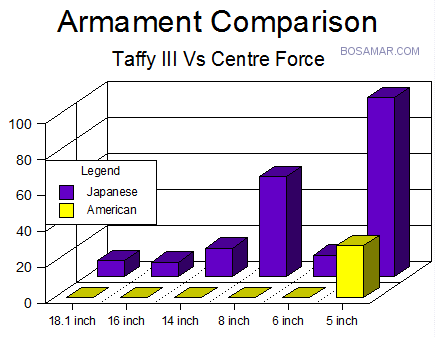 |
In summation, the failure of the enemy main body and encircling light forces to completely wipe out all vessels of this Task Unit can be attributed to our successful smoke screen, our torpedo counter-attack, continuous harassment of the enemy by bomb, torpedo, and strafing air attacks, timely maneuvers, and the definite partiality of Almighty God...."
|
When the Battle of Leyte Gulf was finished, the Imperial Japanese Combined Fleet could never again threaten the U.S. Navy as a capable offensive fighting force. With their sea lanes to their oil fields and raw materials in the southern region severed and their Navy soundly defeated, Japan would unconditionally surrender in less than one year. The performance of the escort carrier group at Leyte Gulf, especially Taffy III, was nothing short of miraculous. One week after the engagement, RADM Thomas Sprague sent the following congratulations communique to his well deserving forces who fought at Leyte: |
CTU 77.4.22/COMCARDIV 27 Action Report All operations of the task unit were conducted smoothly and aggressively, and the unit was given inspiring leadership by the task unit commander, Rear Admiral Felix B. Stump, U.S.N. In particular, by his cool and logical tactical planning on 25 October 1944 he not only maneuvered his task unit so that it suffered no battle damage but also organized and sent off six heavy strikes against the enemy fleet, which strikes materially assisted in turning the Japanese fleet and prevented further damage to our own forces. |
FROM: Commander Escort Carrier Group 77.4
ACTION: All ships and units under my command
DATE: 2 November 1944
INFO: COM7THFLT/
CINCPAC/
COMAIRPAC/
COMDESPAC/
COM3RDFLT/
COM5THFLT
To those officers and men of the escort carriers and to the kin of those who were lost X This task group has participated in one of the decisive battles of this war X The aircraft of these carriers not only have met and defeated enemy attacks in the air but they have turned back a large enemy fleet composed of his most modern ships X The intrepid courage, skill and fighting spirit of the pilots and air crewmen were superb X Never have fighting men had a greater task and never have fighting men performed their duty with greater determination and distinction X The seamanlike handling of the vessels X The brilliant offensive and defensive work of the screen X The sustained and imperturbable handling of planes on deck X The calm singleness of purpose of the rearming and gasoline details X The prompt and efficient action of the damage control parties and the engineers X All contributed to turning the tide of battle to victory X Against such teamwork the enemy could not prevail X I am proud to have been privileged to be present and observe your achievements X May God bless everyone of you and may the citizens of your country forever remember and be thankful for your courage X To the mothers, fathers, sisters and brothers, wives and sons and daughters of those who were lost I say X Do not be sad X Be comforted and inspired in the thought that the victory for which these men so freely and courageously gave their lives has contributed immeasurably to the final defeat of the enemy X
T. L. SPRAGUE (Rear Admiral in charge of all CVEs on Leyte Invasion)
|
Lieutenant Commander Robert W. Copeland of ROBERTS summarized the performance of his officers and men in his Combined Action Report and Loss of ship report: "The performance of officers and enlisted personnel of this command was exemplary - in accordance with the very highest traditions of the United States Naval Service. To witness the conduct of the average enlisted man aboard this vessel, newly inducted, married, unaccustomed to navy ways and with an average of less than one years service would make any man proud to be an average American. The crew were informed over the loud speaker system at the beginning of the action, of the Commanding Officer's estimate of the situation, that is, a fight against overwhelming odds from which survial could not be expected, during which time we would do what damage we could. In the face of this knowledge the men zealously manned their stations wherever they might be, and fought and worked with such calmness, courage, and efficiency that no higher honor could be conceived than to command such a group of men." Commander Leon S. Kintberger of HOEL concluded his Action Report with the following words: |
CTU 77.4.32/COMCARDIV 26 Action Report On the morning of 25 October TU 77.4.3 was operating off the east coast of Samar providing routine support for the Leyte Landing Forces when it was surprised and attacked by a major part of the Japanese Fleet. In the running fight which followed, this unit, while escaping what seemed certain annihilation, lost two of its six CVE's and three of its seven screening vessels. No vessel of this Task Unit escaped undamaged. For about two and one half hours this group was under constant attack, endeavoring to outrun an enemy vastly superior in speed and armament, and to avoid a constant and increasing threat of encirclement by enemy's heavy cruisers on the left, his destroyers on the right, and his main body astern. In this effort some benefits of concealment was derived from the scattered showers that prevailed during the morning, and more from the use of smoke. Nevertheless until the moment when the enemy broke off and retired to the north, there appeared only one possible outcome of the encounter - complete annihilation. |
"The success attained by a small number of light forces in an unsupported, uncoordinated attack against capital ships of a major Japanese task force is far and beyond the wildest expectations. It hardly seems possible that, during daylight, a destroyer could close to ranges of 6,000 and 10,000 yards of a battleship or cruiser, launch torpedoes attacks, and then remain afloat for more than an hour.
The performance of officers and enlisted personnel was up to the very highest traditions of the naval service. Fully cognizant of the inevitable result of engaging such vastly superior forces these men performed their assigned duties cooly and efficiently until their ship was shot from under them. A well trained crew fought their ship smartly."
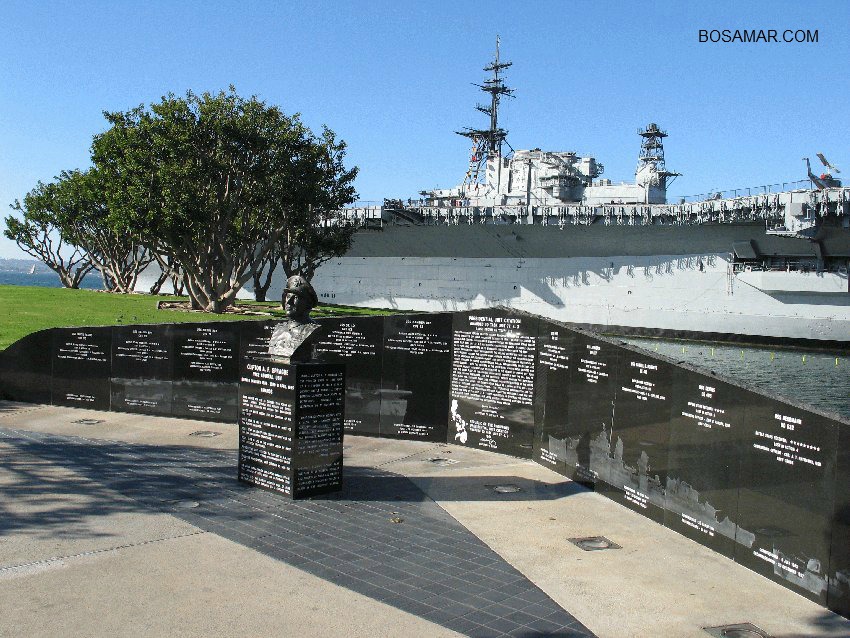
Photograph by Robert Jon Cox
Battle of Leyte Gulf Memorial by Taffy 3
& Admiral Sprague bust by Moom Kim
Harbor Drive, San Diego, California
In his endorsement to JOHNSTON's Action Report Admiral Thomas C. Kinkaid wrote, "The U.S.S. JOHNSTON together with the destroyers HEERMANN and HOEL and the destroyer escorts BUTLER, DENNIS, RAYMOND and ROBERTS interposed themselves between a fast, powerful Japanese Task Force and our slow vulnerable CVE's. By the skillful use of smoke, the launching of daring torpedo attacks, and the refusal to break off the action in the face of overwhelming odds and sure losses this intrepid little group of fighting ships accomplished one of the most heroic and gallant epics of the war. That the JOHNSTON should have been lost was among the calculated risks of such an undertaking. This ship did not go down in vain, largely through its efforts and those of the other ships the Japanese Force was slowed down and turned back. What the Japanese had planned as an American Naval disaster was turned into a Japanese rout. The part played by the JOHNSTON in this cannot be overestimated. The courageous performance of the Commanding Officer, officers and crew of the JOHNSTON in the engagement off Samar Island was in keeping with the highest traditions of the naval service."
|
Let us never forget the heroism and valor displayed by the likes of CDR Ernest E. Evans, CDR Leon S. Kintberger, and LCDR Robert W. Copeland, all of whom valiantly placed their small warships in harm’s way against impossible odds. They gave their all for the defense of the escort carriers. The name's JOHNSTON, HOEL, and ROBERTS are set in stone in the annals of surface warfare history, never to be forgotten. The GAMBIER BAY although overwhelmed by the heavy cruisers, refusing to strike her colors and admit defeat, reflected U.S. Naval tradition at the epitome of its finest hour. The tragic loss of ST LO as a result of the kamikaze strike proved to the Americans that their enemy was more desperate than ever to save their shrinking empire. No matter how great the American superiority was at this point in the war it was still a very long way to final victory in the Pacific. As the Americans drew closer to the Japanese home islands it was only to become more fiercely contested by the cornered Japanese. |
Fleet Admiral Chester W. Nimitz , USN "Here Admiral Clifton Sprague, backed by Admiral Stump and Admiral Thomas Sprague, squeezed every possible advantage from wind, rain, smoke, interior position, and air and surface attack to confuse and repulse an immensely superior enemy. Overhead, the escort carrier planes, untrained for attacking ships, performed like fast carrier aircraft at their best. On the surface, Clifton Sprague's little screening vessels, steaming boldly into battleships and cruiser fire, dodging through smoke and rain, chasing salvos, opposing 14- and 16-inch shells with 5-inch when they had expended their torpedoes, provided the slender margin that enabled the air-attack to succeed and most of the escort carriers to escape. The history of the United States Navy records no more glorious two hours of resolution, sacrifice, and success." |
It was the Navy’s carrier air power that saved Taffy III from complete annihilation. Indeed, it was the aircraft of the sixteen escort carriers present that day aboard the taffies themselves that ultimately saved them. The bond between the men who manned the ships and the men of the composite squadrons is forever strong, each owing the other a great debt of gratitude for what occurred in the heat of battle. Quite rightfully, we shall never forget the sacrifices made by these gallant men, the warships, and their embarked composite squadrons who fought the Imperial Japanese Navy Centre Force so bravely and with high honor off Samar on October 25, 1944.
Continue to INDEX
